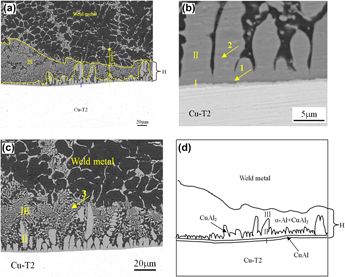Crossref Citations
This article has been cited by the following publications. This list is generated based on data provided by
Crossref.
Khanna, Rohit
Rajeev, Ganapathiyankavu Pisharam
Takadama, Hiroaki
and
Rao Bakshi, Srinivasa
2017.
Fabrication of dense alumina layer on Ti alloy hybrid by cold metal transfer and micro-arc oxidation methods.
Journal of Materials Research,
Vol. 32,
Issue. 17,
p.
3415.
Zhou, Xianglong
Zhang, Gang
Shi, Yu
Zhu, Ming
and
Yang, Fuqian
2017.
Microstructures and mechanical behavior of aluminum-copper lap joints.
Materials Science and Engineering: A,
Vol. 705,
Issue. ,
p.
105.
Jayabalakrishnan, D.
and
Balasubramanian, M.
2018.
Eccentric-weave FSW between Cu and AA 6061-T6 with reinforced Graphene nanoparticles.
Materials and Manufacturing Processes,
Vol. 33,
Issue. 3,
p.
333.
Liu, Yan
Yao, Yu
Ye, Haiqing
and
Zhang, Luxin
2018.
Study on microstructure and properties of dissimilar welded joints of steel and aluminum by CMT welding process.
IOP Conference Series: Materials Science and Engineering,
Vol. 382,
Issue. ,
p.
042025.
Furuya, H. S.
Sato, Y. S.
Kokawa, H.
Huang, T.
and
Xiao, R. S.
2018.
Improvement of Interfacial Strength with the Addition of Ni in Al/Cu Dissimilar Joints Produced via Laser Brazing.
Metallurgical and Materials Transactions A,
Vol. 49,
Issue. 12,
p.
6215.
Ko, Sang-Jin
An, Jeong-Hun
Kim, Yong-Sang
and
Kim, Jung-Gu
2019.
Failure analysis of an Al Cu joint manufactured by eutectic diffusion bonding in evaporator tubes.
Engineering Failure Analysis,
Vol. 98,
Issue. ,
p.
167.
Zhang, Hengming
Shi, Yu
Gu, Yufen
and
Li, Chunkai
2020.
Effect of Different Filler Wires on Mechanical Property and Conductivity of Aluminum-Copper Joints.
Materials,
Vol. 13,
Issue. 16,
p.
3648.
Fan, Ding
Yang, Nan
Huang, Jiankang
and
Yu, Xiaoquan
2021.
Plasma arc welding-brazing of aluminum to copper with SiO2 nanoparticles strengthening.
Journal of Manufacturing Processes,
Vol. 69,
Issue. ,
p.
253.
Furuya, Hiroki S.
Yabu, Sakiko
Sato, Yutaka S.
and
Kokawa, Hiroyuki
2021.
Microstructural Control of the Interface Layer for Strength Enhancement of Dissimilar Al/Cu Joints via Ni Addition during TIG Arc Brazing.
Metals,
Vol. 11,
Issue. 3,
p.
491.
Harati, Ehsan
and
Kah, Paul
2022.
Laser welding of aluminum battery tab to variable Al/Cu busbars in Li-ion battery joint.
AIMS Materials Science,
Vol. 9,
Issue. 6,
p.
884.
Dang, Zongyu
Qin, Guoliang
and
Li, Tongyi
2023.
Microstructure evolution and tensile strength of Al/Cu inertia friction welded joint.
Journal of Materials Research and Technology,
Vol. 27,
Issue. ,
p.
4023.
Mondal, Mounarik
Shin, Joonghan
and
Lee, Donkyoung
2023.
Effect of bottom sheet thickness on weld properties during laser lap welding of aluminum and copper.
The International Journal of Advanced Manufacturing Technology,
Vol. 128,
Issue. 9-10,
p.
4635.
Guo, Jinchang
Li, Chunkai
Bian, Jianxiao
Zhang, Jianrui
and
Geng, Baolong
2023.
Microstructures and Electrical Resistivity of Aluminum–Copper Joints.
Metals,
Vol. 13,
Issue. 8,
p.
1474.
Xu, Wenhu
Yang, Jin
Peng, Mingjian
Zhao, Yixuan
Liu, Hongbin
Deng, Peiran
Gao, Yanfeng
and
Zhang, Hua
2023.
Characteristics of Torch-Offset Cold Metal Transition-Cycle Step Welding of 5052Al Alloy with T2 Copper via Al-12Si Filler.
Journal of Materials Engineering and Performance,
Vol. 32,
Issue. 2,
p.
587.
Wang, Leilei
Li, Nian
Wei, Xinlong
Ling, Xiang
and
Li, Qingsheng
2023.
Effects of nickel layer on interfacial micro-structure distribution and macro-mechanical properties for vacuum-brazed dissimilar steel joints.
Welding in the World,
Vol. 67,
Issue. 10,
p.
2391.
Kaisheva, Darina
Kotlarski, Georgi
Ormanova, Maria
Anchev, Angel
Dunchev, Vladimir
Stoyanov, Borislav
and
Valkov, Stefan
2024.
Electron Beam Welding of Copper and Aluminum Alloy with Magnetron Sputtered Titanium Filler.
Crystals,
Vol. 14,
Issue. 9,
p.
752.
He, Huan
Liu, Zhaoxian
Zhang, Lixin
Liu, Zheng
Tian, Xu
Guo, Dehua
Guo, Zhiwen
Yang, Yarong
Fu, Ao
and
Zhao, Wenzhen
2024.
Microstructure and Properties of Dissimilar Butt Joints of Aluminum to Copper by Cold Metal Transfer with Preheating.
JOM,
Vol. 76,
Issue. 9,
p.
5149.




